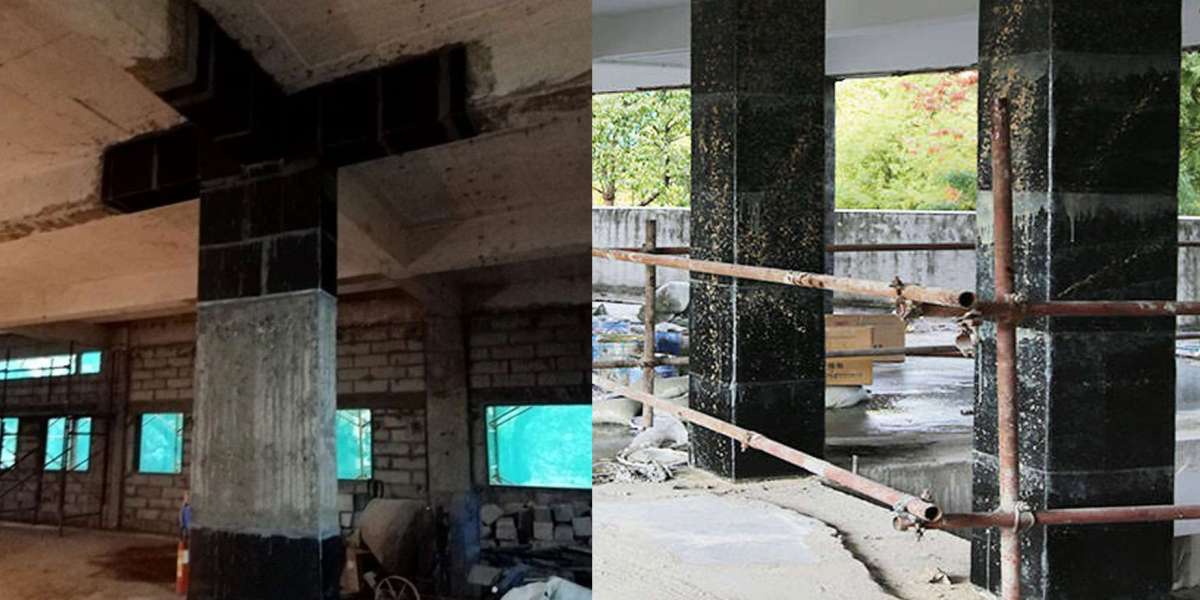Carbon Wrapping for Columns: A Smart Solution for Concrete Structure Reinforcement
In recent years, there has been an increasing demand for sophisticated structural repair methods within the Indian construction industry. As buildings deteriorate and the need for improved infrastructure escalates, engineers and property owners are seeking more dependable solutions. A contemporary approach that is becoming increasingly favored is Carbon Wrapping for Columns. This method provides an effective, lightweight, and exceptionally durable means of reinforcing concrete structures without the necessity for extensive demolition or reconstruction.
Understanding the Need for Column Strengthening
Concrete columns serve as the fundamental support for multi-storey buildings. With the passage of time, they can suffer degradation due to environmental influences, excessive weight, or substandard construction methods. In India, where numerous older structures remain operational, these problems are prevalent. Furthermore, factors such as earthquakes, high humidity, and pollution-induced corrosion can compromise the integrity of these essential structural elements.
Reinforcing or retrofitting columns is crucial to prevent structural failures. Conventional repair techniques typically require additional mass, which may not always be practical. In this context, Carbon Wrapping for Columns offers a clever, space-efficient, and effective solution.
What is Carbon Wrapping and How Does It Work?
Carbon wrapping utilizes carbon fiber reinforced polymer (CFRP) sheets that are encased around concrete columns to enhance their load-bearing capabilities. This material is not only lightweight but also possesses greater strength than steel, making it suitable for structural retrofitting. After the wrapping process, the CFRP is secured with high-strength epoxy resin, creating a robust, flexible, and protective layer around the column. Consequently, this results in a fortified structural component capable of enduring increased loads, impacts, and environmental degradation.
The process begins with a thorough inspection of the existing structure. Engineers assess the damage, measure load requirements, and prepare the surface of the column. Any loose or damaged concrete is removed, and the surface is cleaned.
Next, the CFRP sheets are cut to the desired size. They are then saturated with resin and wrapped around the column in multiple layers. The wrapping is usually done in a spiral or hoop pattern, depending on the required strengthening direction.
Finally, the wrapped column is cured either naturally or using heat, depending on environmental conditions. After curing, the column is ready for use. The entire process is quick, clean, and highly effective.
Key Benefits of Carbon Wrapping for Columns
There are several reasons why engineers and property owners favor carbon wrapping in contemporary applications. Firstly, it is a non-intrusive method that allows the building's operations to continue uninterrupted during the process. Secondly, it does not contribute additional weight to the structure, unlike traditional techniques such as concrete or steel jacketing, which increase the dead load. In contrast, Carbon Wrapping for Columns adds minimal weight while delivering enhanced strength. Thirdly, carbon fiber exhibits resistance to corrosion and chemicals, making it ideal for industrial facilities, coastal constructions, and polluted urban settings. Finally, it offers seismic resistance, which is an increasingly important consideration in various regions of India.
Carbon wrapping utilizes carbon fiber reinforced polymer (CFRP) sheets that are encased around concrete columns to enhance their load-bearing capabilities. This material is not only lightweight but also possesses greater strength than steel, making it suitable for structural retrofitting. After the wrapping process, the CFRP is secured with high-strength epoxy resin, creating a robust, flexible, and protective layer around the column. Consequently, this results in a fortified structural component capable of enduring increased loads, impacts, and environmental degradation.
Why the Indian Market Needs This Technology
India is home to thousands of aging structures, many of which were built before modern building codes were implemented. Public infrastructure like bridges, schools, hospitals, and government buildings face risks if not maintained properly.
There are several reasons why engineers and property owners favor carbon wrapping in contemporary applications. Firstly, it is a non-intrusive method that allows the building's operations to continue uninterrupted during the process. Secondly, it does not contribute additional weight to the structure,
unlike traditional techniques such as concrete or steel jacketing, which increase the dead load. In contrast, Carbon Wrapping for Columns adds minimal weight while delivering enhanced strength. Thirdly, carbon fiber exhibits resistance to corrosion and chemicals, making it ideal for industrial facilities, coastal constructions, and polluted urban settings. Finally, it offers seismic resistance, which is an increasingly important consideration in various regions of India.
Furthermore, rapid urbanisation has increased the vertical expansion of buildings. Older structures that were originally designed for lower occupancy are now being upgraded. This calls for reliable strengthening methods. Carbon Wrapping for Columns serves this exact purpose with efficiency and precision.
Also, India’s diverse climate adds to the wear and tear of concrete. In coastal areas, salt-laden air corrodes steel reinforcement. In the north, freeze-thaw cycles can create cracks. Carbon wrapping acts as a shield against these elements, offering long-term durability.
Applications Across Various Structures
This method is not confined to residential or commercial structures. It is extensively applied in the restoration of infrastructure such as bridges, overpasses, and water storage tanks. Industrial sites, power generation facilities, and historical buildings also gain advantages from its use. In all these scenarios, prolonged operational shutdowns are impractical. Given that Carbon Wrapping for Columns is a swift process that does not necessitate the use of heavy equipment, it facilitates reinforcement with minimal interruption. This characteristic is particularly significant in the Indian context, where downtime can result in substantial economic losses.
India is home to thousands of aging structures, many of which were built before modern building codes were implemented. Public infrastructure like bridges, schools, hospitals, and government buildings face risks if not maintained properly.
Furthermore, rapid urbanisation has increased the vertical expansion of buildings. Older structures that were originally designed for lower occupancy are now being upgraded. This calls for reliable strengthening methods. Carbon Wrapping for Columns serves this exact purpose with efficiency and precision.
The Process of Carbon Wrapping Explained
The procedure commences with a comprehensive evaluation of the current structure. Engineers examine the extent of the damage, determine load specifications, and prepare the column's surface. Any deteriorated or loose concrete is eliminated, and the surface is thoroughly cleaned. Subsequently, the CFRP sheets are tailored to the required dimensions. They are then infused with resin and applied around the column in several layers. Furthermore, rapid urbanisation has increased the vertical expansion of buildings. Older structures that were originally designed for lower occupancy are now being upgraded. This calls for reliable strengthening methods. Carbon Wrapping for Columns serves this exact purpose with efficiency and precision.The application is typically executed in a spiral or hoop configuration, based on the necessary direction for reinforcement. Ultimately, the wrapped column undergoes curing, either naturally or through heat application, contingent on the surrounding conditions. Once cured, the column is ready for utilization. This entire procedure is efficient, tidy, and remarkably effective.


